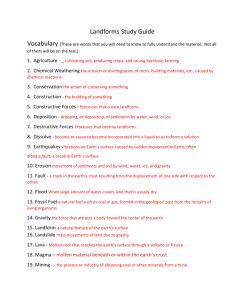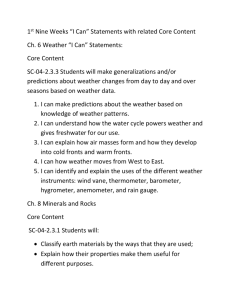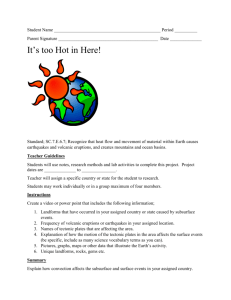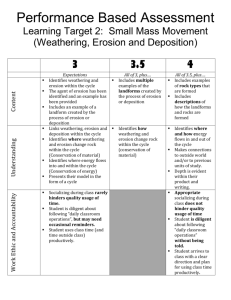6-8 Unit 5: Earth - Lake County Schools
advertisement
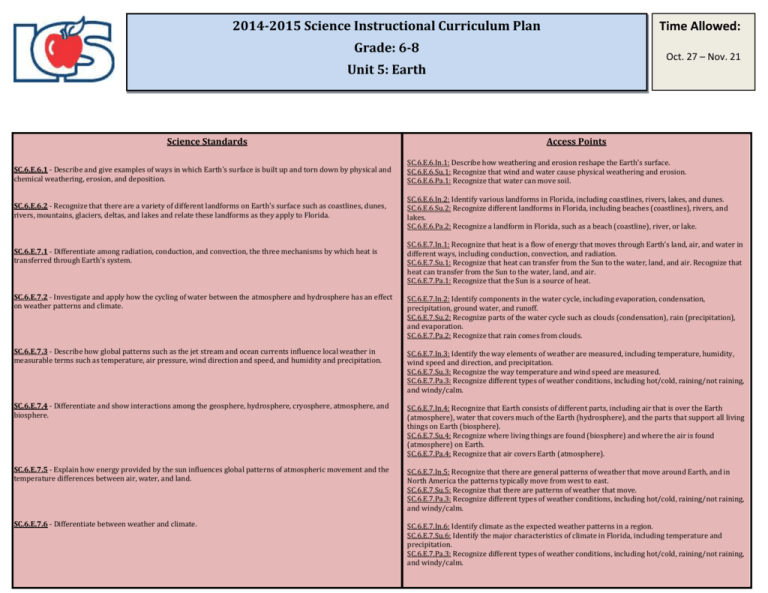
2014-2015 Science Instructional Curriculum Plan Time Allowed: Grade: 6-8 Oct. 27 – Nov. 21 Unit 5: Earth Science Standards Access Points SC.6.E.6.1 - Describe and give examples of ways in which Earth's surface is built up and torn down by physical and chemical weathering, erosion, and deposition. SC.6.E.6.In.1: Describe how weathering and erosion reshape the Earth’s surface. SC.6.E.6.Su.1: Recognize that wind and water cause physical weathering and erosion. SC.6.E.6.Pa.1: Recognize that water can move soil. SC.6.E.6.2 - Recognize that there are a variety of different landforms on Earth's surface such as coastlines, dunes, rivers, mountains, glaciers, deltas, and lakes and relate these landforms as they apply to Florida. SC.6.E.6.In.2: Identify various landforms in Florida, including coastlines, rivers, lakes, and dunes. SC.6.E.6.Su.2: Recognize different landforms in Florida, including beaches (coastlines), rivers, and lakes. SC.6.E.6.Pa.2: Recognize a landform in Florida, such as a beach (coastline), river, or lake. SC.6.E.7.1 - Differentiate among radiation, conduction, and convection, the three mechanisms by which heat is transferred through Earth's system. SC.6.E.7.In.1: Recognize that heat is a flow of energy that moves through Earth’s land, air, and water in different ways, including conduction, convection, and radiation. SC.6.E.7.Su.1: Recognize that heat can transfer from the Sun to the water, land, and air. Recognize that heat can transfer from the Sun to the water, land, and air. SC.6.E.7.Pa.1: Recognize that the Sun is a source of heat. SC.6.E.7.2 - Investigate and apply how the cycling of water between the atmosphere and hydrosphere has an effect on weather patterns and climate. SC.6.E.7.In.2: Identify components in the water cycle, including evaporation, condensation, precipitation, ground water, and runoff. SC.6.E.7.Su.2: Recognize parts of the water cycle such as clouds (condensation), rain (precipitation), and evaporation. SC.6.E.7.Pa.2: Recognize that rain comes from clouds. SC.6.E.7.3 - Describe how global patterns such as the jet stream and ocean currents influence local weather in measurable terms such as temperature, air pressure, wind direction and speed, and humidity and precipitation. SC.6.E.7.In.3: Identify the way elements of weather are measured, including temperature, humidity, wind speed and direction, and precipitation. SC.6.E.7.Su.3: Recognize the way temperature and wind speed are measured. SC.6.E.7.Pa.3: Recognize different types of weather conditions, including hot/cold, raining/not raining, and windy/calm. SC.6.E.7.4 - Differentiate and show interactions among the geosphere, hydrosphere, cryosphere, atmosphere, and biosphere. SC.6.E.7.In.4: Recognize that Earth consists of different parts, including air that is over the Earth (atmosphere), water that covers much of the Earth (hydrosphere), and the parts that support all living things on Earth (biosphere). SC.6.E.7.Su.4: Recognize where living things are found (biosphere) and where the air is found (atmosphere) on Earth. SC.6.E.7.Pa.4: Recognize that air covers Earth (atmosphere). SC.6.E.7.5 - Explain how energy provided by the sun influences global patterns of atmospheric movement and the temperature differences between air, water, and land. SC.6.E.7.In.5: Recognize that there are general patterns of weather that move around Earth, and in North America the patterns typically move from west to east. SC.6.E.7.Su.5: Recognize that there are patterns of weather that move. SC.6.E.7.Pa.3: Recognize different types of weather conditions, including hot/cold, raining/not raining, and windy/calm. SC.6.E.7.6 - Differentiate between weather and climate. SC.6.E.7.In.6: Identify climate as the expected weather patterns in a region. SC.6.E.7.Su.6: Identify the major characteristics of climate in Florida, including temperature and precipitation. SC.6.E.7.Pa.3: Recognize different types of weather conditions, including hot/cold, raining/not raining, and windy/calm. 2014-2015 Science Instructional Curriculum Plan Grade: 6-8 Unit 5: Earth Time Allowed: Oct. 27 – Nov. 21 SC.6.E.7.7 - Investigate how natural disasters have affected human life in Florida. SC.6.E.7.In.7: Identify possible effects of hurricanes and other natural disasters on humans in Florida. SC.6.E.7.Su.7: Recognize possible effects of severe storms, hurricanes, or other natural disasters in Florida. SC.6.E.7.Pa.5: Recognize where to go in severe weather situations or drills at school and at home. SC.6.E.7.8 - Describe ways human beings protect themselves from hazardous weather and sun exposure. SC.6.E.7.In.8: Identify ways humans get ready for severe storms and protect themselves from sun exposure. SC.6.E.7.Su.8: Recognize ways people prepare for severe storms and protect themselves from sun exposure. SC.6.E.7.Pa.5: Recognize where to go in severe weather situations or drills at school and at home. SC.7.E.6.1 - Describe the layers of the solid Earth, including the lithosphere, the hot convecting mantle, and the dense SC.7.E.6.In.1: Identify that Earth has three layers (crust, mantle, and core) and describe the inside metallic liquid and solid cores. (core) as the hottest layer. SC.7.E.6.Su.1: Recognize that the surface of Earth is called the crust. SC.7.E.6.Pa.1: Recognize the ground as the outer surface (crust) of Earth. SC.7.E.6.2 - Identify the patterns within the rock cycle and relate them to surface events (weathering and erosion) and sub-surface events (plate tectonics and mountain building). SC.7.E.6.In.2: Recognize that slow changes, such as mountain-building, and fast changes, such as volcanic eruptions, are caused by shifts below Earth’s surface. SC.7.E.6.Su.2: Recognize that mountains change size and shape over a long period of time. SC.7.E.6.Pa.2: Discriminate between surface features of ground on Earth, such as rocky/sandy, flat/hilly, rough/smooth, or solid/liquid. SC.7.E.6.3 - Identify current methods for measuring the age of Earth and its parts, including the law of superposition and radioactive dating. SC.7.E.6.In.3: Demonstrate how older rock layers are deposited at the bottom before younger layers (Law of Superposition). SC.7.E.6.Su.2: Recognize that mountains change size and shape over a long period of time. SC.7.E.6.Pa.3: Recognize that ground on the Earth’s surface changes over time. SC.7.E.6.4 - Explain and give examples of how physical evidence supports scientific theories that Earth has evolved over geologic time due to natural processes. SC.7.E.6.In.4: Identify physical evidence, such as fossils and sedimentary rock, which show how Earth has changed over a very long period of time. SC.7.E.6.Su.3: Recognize that fossils are remains or imprints of living things from long ago. SC.7.E.6.Pa.3: Recognize that ground on the Earth’s surface changes over time. SC.7.E.6.5 - Explore the scientific theory of plate tectonics by describing how the movement of Earth's crustal plates causes both slow and rapid changes in Earth's surface, including volcanic eruptions, earthquakes, and mountain building. SC.7.E.6.In.2: Recognize that slow changes, such as mountain-building, and fast changes, such as volcanic eruptions, are caused by shifts below Earth’s surface. SC.7.E.6.Su.4: Recognize the effects of earthquakes and volcanoes. SC.7.E.6.Pa.2: Discriminate between surface features of ground on Earth, such as rocky/sandy, flat/hilly, rough/smooth, or solid/liquid. SC.7.E.6.6 - Identify the impact that humans have had on Earth, such as deforestation, urbanization, desertification, erosion, air and water quality, changing the flow of water. SC.7.E.6.In.5: Recognize that humans have had an impact on Earth, such as polluting the air and water and expanding urban areas and road systems. SC.7.E.6.Su.5: Recognize that polluting the air and water can harm Earth. SC.7.E.6.Pa.3: Recognize that ground on the Earth’s surface changes over time. SC.7.E.6.7 - Recognize that heat flow and movement of material within Earth causes earthquakes and volcanic eruptions, and creates mountains and ocean basins. SC.7.E.6.In.4: Identify physical evidence, such as fossils and sedimentary rock, which show how Earth has changed over a very long period of time. SC.7.E.6.Su.4: Recognize the effects of earthquakes and volcanoes. SC.7.E.6.Pa.4: Distinguish between clean and dirty water.




